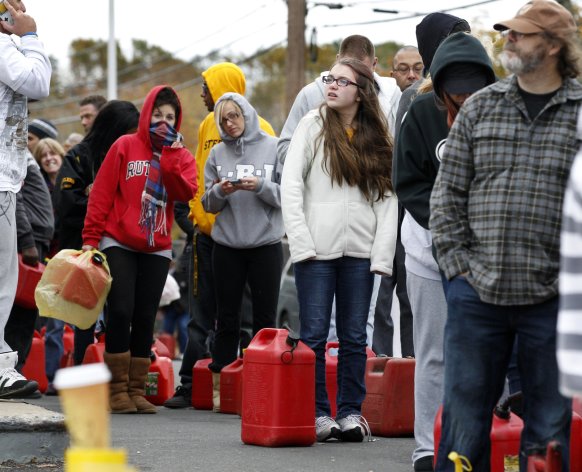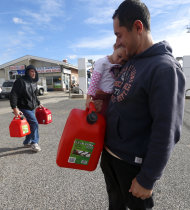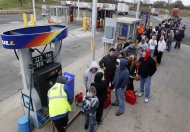Gas stations scramble in Sandy's aftermath
By | Associated Press – 6 hrs ago
Associated Press/Mel Evans - As temperatures begin to drop, people wait in line to fill containers with gas at a Shell gasoline filling station Thursday, Nov. 1, 2012, in Keyport, N.J. In parts of New York
RELATED CONTENT
NEW YORK (AP) — There's plenty of gasoline in the Northeast — just not at gas stations.
In parts of New York and New Jersey,
drivers lined up Thursday for hours at
gas stations that were struggling to stay
supplied.
The power outages and flooding caused
by Superstorm Sandy have forced many
gas stations to close and disrupted the
flow of fuel from refineries to those
stations that are open.
At the same time, millions of gallons of
gasoline are sitting at the ready in
storage tanks, pipelines and tankers
that can't unload their cargoes.
"It's like a stopped up drain," said Tom Kloza, Chief Oil
Analyst at the Oil Price Information Service.
For people staying home or trying to restart a business, the
scene wasn't much brighter: Millions were in the dark and
many will remain so for days. As of Thursday, 4.5 million
homes were without power, down from a peak of 8.5
million.
The New Jersey utility Public Service Electric & Gas said it
will restore power to most people in 7 to 10 days.
Consolidated Edison, which serves New York City and
Westchester County, said most customers will have power
by Nov. 11, but some might have to wait an additional week
or longer.
Superstorm Sandy found a host of ways to cripple the
region's energy infrastructure. Its winds knocked down
power lines and its floods swamped electrical substations
that send power to entire neighborhoods.
It also mangled ports that accept fuel tankers and flooded
underground equipment that sends fuel through pipelines.
Without power, fuel terminals can't pump gasoline onto
tanker trucks, and gas stations can't pump fuel into
customers' cars.
The Energy Department reported Thursday that 13 of the
region's 33 fuel terminals were closed.
Sections of two major pipelines that serve the area — the
Colonial Pipeline and the Buckeye Pipeline — were also
closed.
Thousands of gas stations in New Jersey and Long Island
were closed because of a lack of power.
AAA estimates that 60 percent of the stations in New Jersey
are shut along with up to 70 percent of the stations in Long
Island.
Thursday morning the traffic to a Hess station on 9th
Avenue in New York City filled two lanes of the avenue for
two city blocks. Four police officers were directing the slow
parade of cars into the station.
A few blocks away, a Mobil station sat empty behind orange
barricades, with a sign explaining it was out of gas.
Taxi and car service drivers were running dry — and giving
up, even though demand for rides was high because of the
crippled public transit system. Northside Car Service in
Williamsburg, Brooklyn has 250 drivers available on
a typical Thursday evening. Today they had just 20.
"The gas lines are too long," said Thomas Miranda, an operator at Northside.
Betty Bethea, 59, waited nearly three hours to get to the
front of the line at a Gulf station in Newark, but she brought
reinforcements: Her kids were there with gas cans, and her
husband was behind her in his truck.
Bethea had tried to drive to her job at a northern New
Jersey Kohl's store on Thursday morning, only to find her
low-fuel light on. She and her husband crisscrossed the
region in search of gas and were shooed away by police at
every closed station she encountered.
"It is crazy out here — people scrambling everywhere,
cutting in front of people. I have never seen New Jersey like
this," Bethea said.
But relief appeared to be on the way, even as the lines grew
Thursday. The Environmental Protection Agency lifted
requirements for low-smog gasoline, allowing deliveries of
gasoline from other regions. Tanker trucks sped north from
terminals in Baltimore and other points south with fuel.
A big delivery of fuel was on its way south to Boston from
a Canadian refinery. Ports and terminals remained open in
Connecticut, Rhode Island, and Pennsylvania, and portions
of the Colonial and Buckeye pipelines are expected to re-
open on Friday. Kinder Morgan Energy Partners expects to
open its three terminals in New Jersey and New York over
the next two days after bringing in backup generators.
And the U.S. Coast Guard opened the Port of New York and
New Jersey to tankers Thursday.
Logistical problems will remain, though, for days. Barges
can now visit terminals up the Hudson River and into Long
Island Sound, but many of the major fuel hubs and
terminals near the New York and New Jersey ports still can't
offload fuel. They need to get electricity back, pump water
out of flooded areas, and inspect equipment before starting
operations again.
And gas stations won't be able to open up until they have
power, either.
That means tanker trucks will have to travel further to
deliver fuel to stations, and customers will have to drive
further to find open stations.
It does not mean, however, that the region will run out of
gasoline. OPIS's Kloza suspects the long lines are partly
a result of panic-buying.
"This is not the Arab Oil Embargo again," he said. "There are
moments when hysteria is warranted, and moments it's not.
Right now, it's not."
Prices shouldn't spike like they did in the 1970s — or even
as they did before Hurricane Isaac slammed the Gulf Coast
this summer. There may be a short-term increase, but gas
prices should resume what has been a 6-week slide.
Gasoline demand is very low at this time of year, and there's
enough fuel to go around — as soon as it can get around.
The national average gasoline price fell a penny to $3.51 per
gallon Thursday, according to AAA, OPIS and Wright
Express. Six weeks ago the price was $3.87.
Patrick DeHaan of GasBuddy.com, which collects gasoline
prices from thousands of drivers, said prices weren't
spiking in New York and New Jersey on Thursday. It was
just a matter of finding stations that were open and had
fuel.
___
Samantha Henry and Michael Rubinkam contributed to this story from Newark, N.J.
___
Follow Jonathan Fahey on Twitter at http://twitter.com/JonathanFahey .


No comments:
Post a Comment
Note: Only a member of this blog may post a comment.